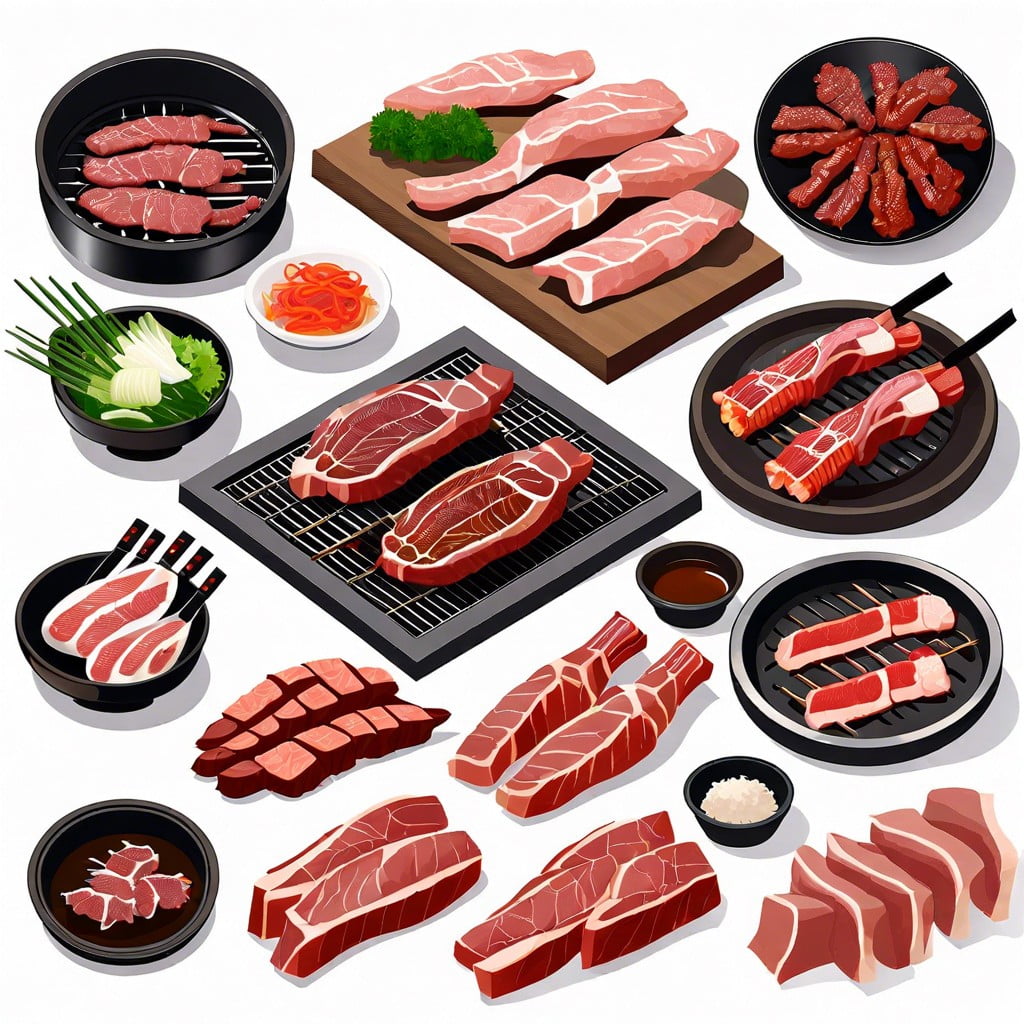Learn the proper way to relish Korean BBQ and enhance your dining experience with these straightforward steps.
Key takeaways:
- Select the right cuts of meat for Korean BBQ.
- Understand the different Korean barbecue sauces and their uses.
- Master grilling techniques and timing for optimal results.
- Follow Korean barbecue etiquette for a communal dining experience.
- Explore and savor the array of Korean side dishes, known as banchan.
Selecting the Right Cuts of Meat

Choosing the proper meat is foundational for a successful Korean BBQ experience. Opt for well-marbled cuts like ribeye, which retain a succulent texture after grilling.
Thin slices of brisket, known as chadolbaegi, cook quickly and are ideal for a crispy exterior and tender interior.
For an authentic touch, samgyeopsal, or pork belly, offers a rich, savory flavor.
Alternatively, bulgogi, thinly sliced beef marinated in soy sauce and sugar, infuses the meal with sweet and savory notes.
When available, galbi – beef short ribs in a garlicky soy marinade – provide a robust taste that’s both traditional and beloved.
Remember, the cut you choose will dictate the flavor and grilling time, shaping your overall dining experience.
Understanding Korean Barbecue Sauces
Korean barbecue is characterized by its dynamic range of flavors, and understanding the sauces used is crucial to enhancing the dining experience. The most common is ssamjang, a thick, spicy paste made from fermented soybean and red chili. It’s typically smeared onto a lettuce leaf before adding meat and sides.
Another staple is gochujang, a red chili paste with miso-like flavor, that adds a significant kick and depth. For a sweeter profile, ganjang, or seasoned soy sauce, imparts a savory umami taste without the heat.
These sauces are not only used as a dip but also to marinate meats such as bulgogi and galbi before they hit the grill. The key is to experiment and find the right balance of flavors to complement the specific cuts of meat you’ve selected.
Grilling Techniques and Timing
Control the heat for different types of meat: Use a high heat for thin slices to sear the outside while keeping the inside tender, and medium heat for thicker cuts to cook them through evenly.
Opt for frequent flipping: Rather than letting meat sit for long periods, turn it over often to ensure a uniform cook and to prevent charring.
Monitor cooking times closely: Since Korean BBQ commonly involves thinly sliced meat, it cooks rapidly, often needing just a couple of minutes per side.
Embrace the smoke: Allow the natural fats to drip onto the charcoal, creating smoke that imparts a signature flavor to the meat. However, keep a watchful eye to avoid flare-ups that could burn the meat.
Use scissors for precision: Traditional Korean grills are equipped with meat scissors to cut larger pieces into bite-sized morsels, ensuring they cook quickly and evenly.
Test for doneness: Given the communal style of eating, you can remove pieces that are ready and let others continue cooking to suit different preferences for doneness.
Korean Barbecue Etiquette
Dining at a Korean barbecue comes with its set of customs that enhance the communal experience. When at the grill, it’s respectful to wait until everyone is served before eating. Chopsticks are preferred, and passing food directly from chopstick to chopstick is considered poor manners.
If you’re a guest, your host may cook for you, a sign of hospitality; receive this graciously. Lettuce wraps, a staple of the meal, are meant to be eaten in one bite regardless of size, allowing for a blend of flavors and textures.
Drink pouring is a mutual gesture; always use both hands as a sign of respect when serving or receiving. Lastly, it’s customary to avoid placing personal items on the table to maintain cleanliness and order.
Navigating Banchan: The Array of Korean Side Dishes
Banchan, the small side dishes served with Korean BBQ, are integral to the experience. They offer a diverse range of flavors and textures, complementing and contrasting with the rich meats.
– Sample a little of each dish to explore varieties like kimchi (fermented vegetables), namul (seasoned vegetables), and jeon (pancakes).
– Pair bites of banchan with the grilled meats to cleanse the palate and enhance flavors.
– Pace yourself – while banchan can be refilled, the focus should remain on the barbecue.
– Embrace the communal style, sharing dishes across the table.
– Enjoy the interplay of spicy, sweet, and savory that banchan brings to the meal.

